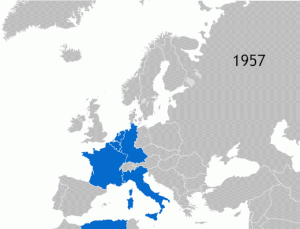 Image via Wikipedia
Image via WikipediaDiscover the key economic factors that drive euro pricing, how the ongoing debt crisis could impact Eurozone nations, and whether the single currency will ever supplant the dollar as the world’s reserve currency.
The euro is second only to the US dollar in its significance in the international currency market. The euro is not only the second-most-actively-traded currency, but it is also a primary or secondary reserve currency for many countries.
The euro is very nearly a unique currency in the world. Although other currency unions predate the euro (including the West African CFA franc), most monetary unions involve small countries with relatively little international importance. With the adoption of the euro in 1999, though, major global currencies like the German mark, French franc, and Dutch guilder effectively disappeared from use.
The euro is the official currency of the Eurozone, and of 17 of the 27 member states of the European Union (EU), with countries like the United Kingdom, Sweden, and Denmark maintaining their own independent currencies. Switzerland is not a part of the European Union.
Members of the EU had to meet strict fiscal criteria to join (including limits on budget deficits and inflation) and the countries surrender their sovereignty over monetary policy to the European Central Bank (ECB).
As a bloc, the European Union has the largest GDP in the world and is the largest exporter in the world.
The Economy Behind the Euro
Unlike the other major currencies of the world, there is no singular economy behind the euro. Speaking about the health of the Eurozone, then, is really tantamount to speaking of the overall health of its 17 euro-bound members. Even then, though, it is important to realize that it is not a uniform region with a single fiscal policy; Germany can be strong while France is weak, and vice versa.
International trade is quite important to the economy of the Eurozone, and exports are a larger percentage of its GDP than of the United States or Japan. These are relatively industrialized countries, though, so manufacturing and services are a much more significant part of the economy.
Few Eurozone members are significant commodity producers (Norway is a notable exception) and the price of commodity imports can be a significant factor in the health of the region.
While it can be challenging enough to monitor the economic reports of a single country, the euro takes it a step further. In practice, though, it is not necessary to monitor the data coming out of every member country, as France, Germany and Italy account for almost two-thirds of the GDP of the Eurozone.
It is certainly important, though, to monitor the data from Eurostat (the statistical directorate of the European Union)—particularly trade balances, GDP, inflation, and Eurozone sentiment indicators. Beyond that, it is often fruitful to monitor those specific reports from Germany and France as well.
source: moneyshow.com
please give me comments thanks


 8:42 AM
8:42 AM
 admin
admin


 Posted in:
Posted in: 


0 comments:
Post a Comment